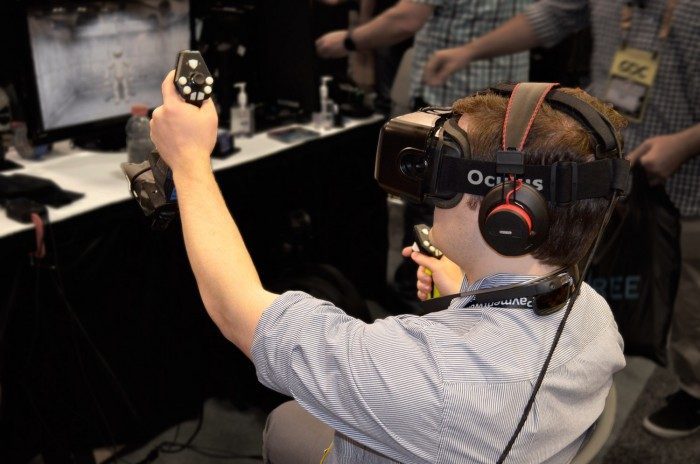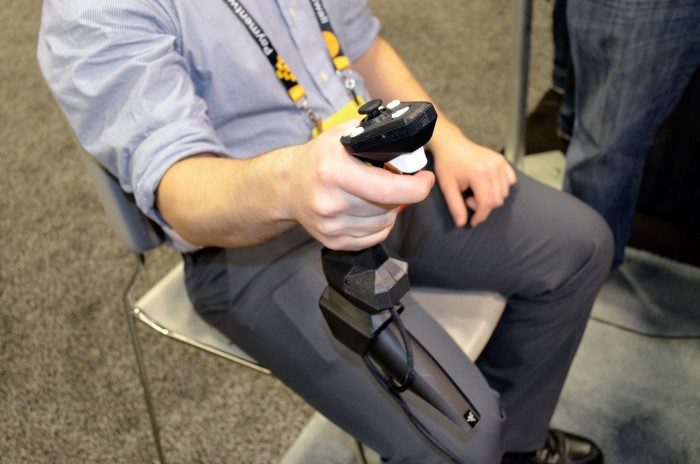As Ben Lang says in his interview introduction, Will Provancher is one of the OG’s of virtual reality. Tactical Haptic’s ‘Reactive Grip’ controller was one of the few peripherals shown back at GDC 2013 that aimed to enhance immersion compared with standard input devices. The Road to VR team caught up with Tactical Haptics again at GDC 2015 to chart the system’s progress over the last 2 years.
Tactical Haptics haven’t had the smoothest of rides since their GDC debut in 2013. Despite the company’s ‘Reactive Grip’ technology providing one of the biggest advancements to force feedback controller technology for some time,
their Kickstarter faltered and they struggled to find a solid commercial footing with which to develop and market the device.
At GDC 2015 however, Will Provancher was once again optimistic about the company’s fortunes, having won a grants from NASA and NSF (National Science Foundation), they’re currently in residence at StartX, a Standford-affiliated non-profit organization set out to accelerate entrepreneurs “through experiential education.”
Tactical Haptics has also shipped controllers to developers as part of it’s closed beta programme, something that Provancher alludes to in the interview; “While we have been working on some further technology developments, what we’re really trying to do is work shoulder-to-shoulder with some content developers so that we have really great content, for when we go back out and do pre-sales.”
The company is also investigating different development paths, one to enhance the technology to make for a more commercially attractive product to break into the consumer space. “The NSF one is actually looking at adapting what we’re doing to try and find out minimal device or our so-called MVP, Minimal Viable product for gaming.” The primary aim here is to streamline the Reactive Grip tech to be more attractive for inclusion in existing input devices or for licensing to companies like Sony, Microsoft etc.

The NASA grant is for R&D into how Reactive Grip can enhance tele-operation, the practice of remotely controlling apparatus at distance – in NASA’s case, remotely operating tele-operated robots in space for example. “Let’s say you’re an Astronaut. Every time you go out into space there’s risk … if I can have a tele-robot have the same level of dexterity, or at least approaching your level of dexterity, one: I can take advantage of your human experience … and two: buy having those forces, I can not damage what’s in the environment…”
Road to VR’s Scott Hayden went hands-on with the latest prototype shown at GDC, here are his impressions.
I was blindly handed the latest prototype of Reactive Grip, a 3D printed affair resembling an un-hinged flight stick with three sliding plates on the grip section of the device. It was wired up to a brick-sized pack, which Provancher said would eventually disappear into the handle of the device in future iterations. I had heard the grip plates were supposed to do… something. Slide up and down? Just how that was going to translate into anything resembling virtual movement in the real world, I didn’t know for sure.
I cranked down on the grip, fingered the trigger and released a volley at a walking tin can of a robot in the DK2 demo I was currently playing. The device jerked in my hand, giving me a small but satisfying kick back. I used a Portal-esque gravity gun in the next demo and picked up 4 differently sized boxes, feeling the twist and a sensation that bordered on weight… that wasn’t exactly weight, but it wasn’t exactly not weight either. You might need to be a professor of mechanical engineering to explain it, which Provancher is. The third demo gave me the opportunity to set a fixed point, and like a rubber rand, stretch away from the point farther and farther, feeling increasing force in my hand.
Reactive Grip is the first device to give me something, anything in a landscape of devices that have so far shown to be nothing more than glorified rumble packs, and when it finally gets the spatial tracking it deserves, this is a device to watch out for in the new field of consumer haptics.
You can find more information on Tactical Haptics and their Reactive Grip technology
at their website.








